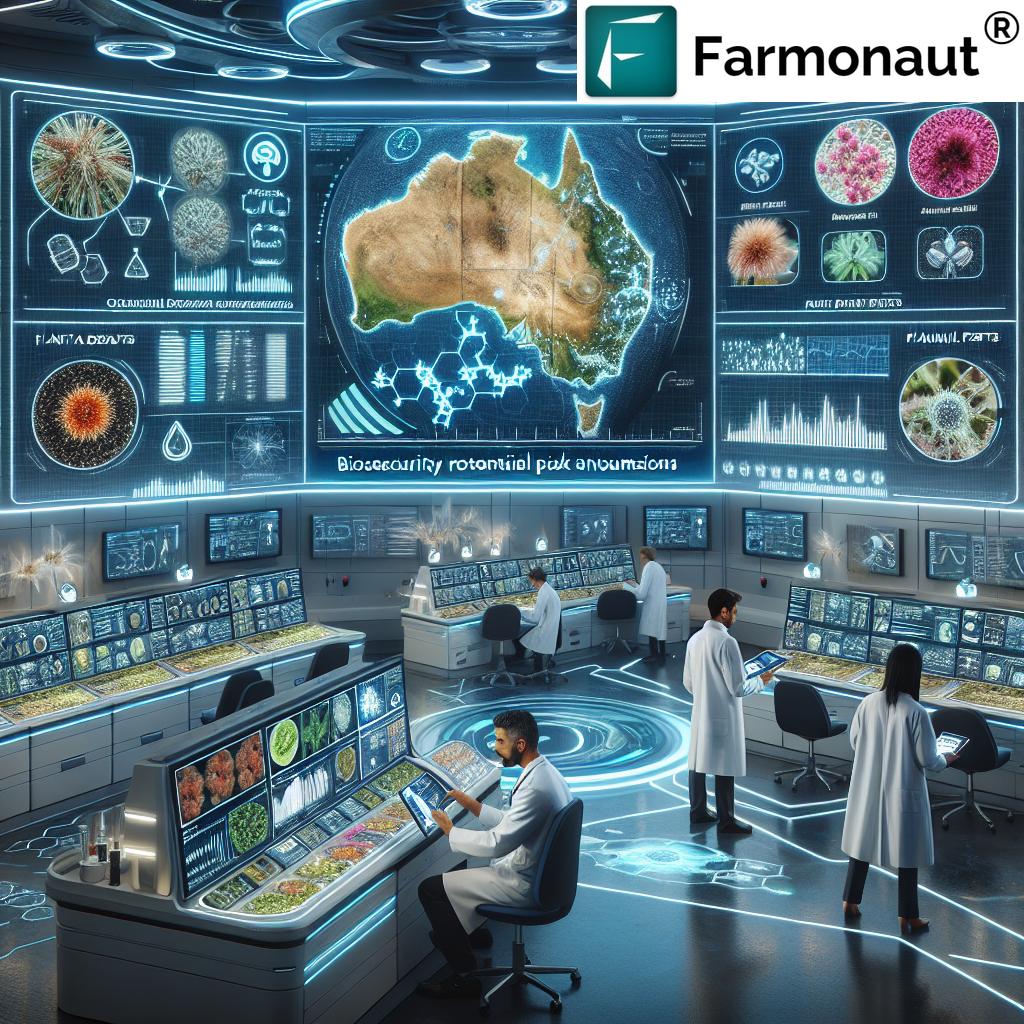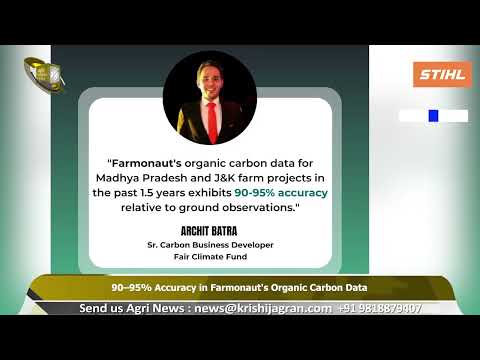Revolutionizing Plant Biosecurity: Farmonaut’s Digital Diagnostics for Australia’s Agricultural Pest Management

“AI-powered pest detection systems can identify up to 98% of common crop diseases within seconds of image analysis.”
In the ever-evolving landscape of agriculture, plant biosecurity stands as a critical pillar safeguarding our food systems, trade relationships, and ecological balance. As we navigate the complexities of global agriculture, the integration of innovative agritech systems has become paramount in fortifying our defenses against biological threats to plant health. At the forefront of this revolution is Farmonaut, pioneering digital plant health solutions that are reshaping the way we approach agricultural pest management and crop protection strategies.
In this comprehensive exploration, we delve into the transformative role of plant biosecurity diagnostics and how cutting-edge technologies are bolstering Australia’s national biosecurity network. We’ll uncover the intricacies of emergency plant pest response protocols and examine how pest surveillance technology is evolving to meet the challenges of the 21st century.
The Evolving Landscape of Plant Biosecurity
Plant biosecurity is no longer confined to traditional methods of visual inspection and manual sampling. The digital age has ushered in a new era of diagnostics, where artificial intelligence, satellite imagery, and advanced data analytics converge to create a robust biosecurity infrastructure. This shift is not just an upgrade; it’s a complete overhaul of how we detect, identify, and manage plant pests and diseases.
- Enhanced early detection capabilities
- Rapid response to emerging threats
- Improved accuracy in pest identification
- Streamlined communication within biosecurity networks
The integration of these digital tools into Australia’s agricultural landscape is transforming pest management strategies, enabling a proactive rather than reactive approach to plant health challenges.
Farmonaut’s Contribution to Digital Plant Health Solutions
At the heart of this technological revolution is Farmonaut, a company dedicated to making precision agriculture accessible and affordable. Through its suite of advanced, satellite-based farm management solutions, Farmonaut is empowering farmers and biosecurity experts alike with the tools they need to protect and optimize crop health.
Farmonaut’s platform integrates several key technologies that are instrumental in revolutionizing plant biosecurity:
- Satellite-Based Crop Health Monitoring: Utilizing multispectral satellite imagery to provide real-time insights into vegetation health, soil moisture, and other critical metrics.
- Jeevn AI Advisory System: An AI-driven tool that delivers personalized farm advice, weather forecasts, and expert crop management strategies.
- Blockchain-Based Product Traceability: Ensuring transparency and security in agricultural supply chains, critical for managing biosecurity risks.
These technologies come together to form a comprehensive digital diagnostics system that enhances our ability to manage plant health and respond swiftly to potential threats.
Strengthening Australia’s National Biosecurity Network
Australia’s unique ecosystem and agricultural industry require a robust and adaptive biosecurity system. The integration of digital plant health solutions into the national biosecurity network has significantly enhanced the country’s ability to protect its agricultural assets and natural environment.
“Advanced biosecurity networks have reduced response times to new plant pest threats by 40% in the last decade.”
Key improvements in the national biosecurity network include:
- Faster detection and identification of potential threats
- More efficient allocation of resources for pest management
- Enhanced collaboration between government agencies, research institutions, and farmers
- Improved data sharing and analysis for predictive modeling
By leveraging Farmonaut’s digital solutions, Australia is building a more resilient and responsive biosecurity infrastructure capable of meeting the challenges of modern agriculture.
Emergency Plant Pest Response: A Digital Revolution
When it comes to emergency plant pest response, time is of the essence. Traditional methods often struggled with the speed and accuracy needed to contain and eradicate new pest incursions effectively. However, with the advent of digital diagnostics and pest surveillance technology, the landscape of emergency response has been transformed.
Farmonaut’s platform plays a crucial role in this transformation by providing:
- Real-time alerts for potential pest outbreaks
- AI-assisted identification of pests and diseases
- Rapid dissemination of information to relevant stakeholders
- Coordinated response planning through digital platforms
These capabilities significantly reduce the time between detection and response, crucial for minimizing the impact of plant pest incursions.
The Role of Pest Surveillance Technology in Modern Agriculture
Pest surveillance has evolved from manual field inspections to sophisticated, technology-driven systems. These advancements have revolutionized our ability to monitor vast agricultural areas efficiently and accurately.
Farmonaut’s contribution to pest surveillance includes:
- Satellite imagery for large-scale monitoring of crop health
- AI algorithms for detecting anomalies in plant growth patterns
- Integration of climate data for predictive pest modeling
- Mobile applications for on-the-ground reporting and data collection
This comprehensive approach to surveillance enables early detection of pest threats, allowing for timely interventions and more effective pest management strategies.
Crop Disease Identification: Precision and Speed
Accurate and rapid crop disease identification is crucial for effective plant health management. Traditional methods often relied on visual inspections by experts, which could be time-consuming and sometimes inaccurate. Digital solutions have revolutionized this process.
Farmonaut’s platform enhances crop disease identification through:
- Machine learning algorithms trained on vast datasets of plant diseases
- High-resolution satellite imagery for detecting disease patterns across large areas
- Integration with on-ground sensors for real-time data collection
- Collaborative platforms for sharing and verifying disease identification
These tools not only speed up the identification process but also improve its accuracy, enabling faster and more targeted responses to disease outbreaks.
Plant Health Risk Mitigation: A Data-Driven Approach
Mitigating risks to plant health requires a comprehensive understanding of various factors, including climate conditions, pest populations, and crop vulnerabilities. Digital solutions have transformed risk mitigation strategies by providing data-driven insights and predictive capabilities.
Farmonaut contributes to plant health risk mitigation through:
- Advanced weather forecasting integrated with crop health data
- Predictive modeling of pest and disease outbreaks
- Customized risk assessment reports for individual farms
- Real-time alerts for potential threats based on data analysis
By leveraging these tools, farmers and biosecurity experts can implement proactive measures to protect crops and minimize potential losses.
The Future of Biosecurity Infrastructure Development
As we look to the future, the development of biosecurity infrastructure will be increasingly driven by technological advancements. The integration of digital solutions into every aspect of plant health management is creating a more resilient and adaptive biosecurity system.
Key areas of future development include:
- Enhanced integration of IoT devices for real-time monitoring
- Advanced AI systems for autonomous decision-making in pest management
- Blockchain technology for secure and transparent data sharing across biosecurity networks
- Augmented reality tools for on-site diagnostics and training
Farmonaut is at the forefront of these developments, continuously innovating to meet the evolving needs of the agricultural sector and biosecurity challenges.
The Critical Role of Diagnosticians in the Digital Age
While digital technologies have revolutionized plant biosecurity, the role of human experts remains crucial. Diagnosticians are now equipped with powerful tools that enhance their capabilities and efficiency.
Farmonaut’s platform supports diagnosticians by:
- Providing access to vast databases of pest and disease information
- Offering AI-assisted diagnostic tools for complex cases
- Facilitating collaboration and knowledge sharing among experts
- Streamlining the process of data collection and analysis
This synergy between human expertise and digital tools is creating a more robust and effective diagnostic capability in the field of plant biosecurity.
Comparative Analysis: Traditional vs. Digital Plant Biosecurity Methods
| Aspect | Traditional Methods | Digital Solutions by Farmonaut |
|---|---|---|
| Pest Detection | Visual inspection by field agents | AI-powered image recognition and satellite monitoring |
| Disease Identification | Laboratory testing of samples | Real-time AI analysis of plant imagery |
| Early Warning Systems | Manual reporting and data compilation | Automated alerts based on real-time data analysis |
| Data Collection | Paper-based surveys and manual input | IoT sensors and mobile app data collection |
| Response Time | Days to weeks | Hours to days |
| Estimated Efficiency | Baseline | 40% faster response time |
Conclusion: Embracing the Digital Future of Plant Biosecurity
As we’ve explored throughout this article, the integration of digital plant health solutions into Australia’s agricultural pest management strategies is transforming the landscape of plant biosecurity. From enhancing our ability to detect and respond to threats, to revolutionizing how we manage and mitigate risks, these innovative technologies are paving the way for a more secure and productive agricultural future.
Farmonaut’s contributions to this digital revolution are significant, offering farmers and biosecurity experts powerful tools to protect and optimize crop health. As we continue to face challenges such as climate change, emerging pests, and the need for increased food production, the role of digital diagnostics and innovative agritech systems will only grow in importance.
By embracing these technological advancements and continuing to invest in the development of robust biosecurity infrastructure, we can build a more resilient and sustainable agricultural sector. The future of plant biosecurity is digital, and it’s a future that promises greater food security, more efficient resource use, and better protection for our valuable plant resources.
Frequently Asked Questions (FAQ)
- What is plant biosecurity?
Plant biosecurity refers to the set of measures designed to protect a country’s plant resources from harmful pests and diseases, including prevention, early detection, and management of threats. - How does Farmonaut contribute to plant biosecurity?
Farmonaut provides digital plant health solutions that include satellite-based crop monitoring, AI-driven advisory systems, and blockchain-based traceability, enhancing the ability to detect, identify, and manage plant pests and diseases. - What are the benefits of digital diagnostics in plant biosecurity?
Digital diagnostics offer faster detection, more accurate identification, and improved response times to plant health threats. They also enable large-scale monitoring and data-driven decision-making. - How does AI assist in pest detection?
AI algorithms analyze satellite imagery and ground-level data to identify anomalies in plant growth patterns, potentially indicating pest or disease presence before visual symptoms appear. - What role does blockchain play in plant biosecurity?
Blockchain technology ensures transparent and secure tracking of agricultural products, helping to trace the origin and movement of potentially infected plants or products, crucial for managing biosecurity risks.
For more information on how Farmonaut can help revolutionize your approach to plant biosecurity and agricultural pest management, visit our web app or explore our API for custom integrations. You can also find detailed information in our API Developer Docs.






